
https://promonaija.com/how-to-choose-the-perfect-smartphone-to-buy-1272
Should I buy a second-hand phone? Is usually the question on our minds when we want to buy a smartphone. Second-hand phones are usually phones that have been used but restored to 'as new' condition, or graded to a certain level of quality. The second-hand phone market is a popular one, but you do need to be careful about what you buy.
A great mobile phone will take the place of your camera, keep you informed and entertained on the move and still leave you with enough battery when you get home. But it's not easy to find a model that can succeed on all counts. With prices rising and more than ever to choose from, it's important to spend your money wisely on a phone that will last.
Image result for high schoolers browsing on phones
Picking a new smartphone can be tough, especially if you're looking at the plethora of Android options at your disposal.
Here are the basic and vital information you need to look out for
Learn some basic differences between operating systems.
· iPhone (aka iOS) is known for its ease of use, security, and clean integration with other Apple products.
· Android is associated with its integration of Google services, its ability to be customized, and typically a lower cost.
· If you can, try demoing a device at a store. That will give you a good sense of the interface and feel of each operating system.
Pick a screen size.
You’re going to spend many hours gazing at it, so make sure that your smartphone screen is a good size for you and that it boasts a high resolution. Screen size is measured corner to corner diagonally. Ultimately, screen size is a matter of preference. Smaller screen phones may fit better in your pocket and are often cheaper. Larger displays may be preferable if you plan to watch a lot of videos.
· iPhone offers the “SE” series for compact phones and the “Plus” series for an extra-large screen.
· Android phones come in a wide range of sizes: there are smaller budget models such as Moto G or Galaxy S Mini, higher-end models like the Galaxy S or the HTC One series, and oversized models like Galaxy Note or Nexus 6P.
Determine your price range.
You need to have a budget on the price range you want so as to help narrow your choices. After that find out the price of various brand phones which you can do easily online by visiting famous sites like Jumia, Slot etc.
iOS phones (iPhones) are typically more expensive than their Android counterparts. Among phone manufacturers, Apple and Samsung are typically among the most expensive, while HTC, LG, and Motorola tend to produce lower-cost options.
· Phones are subsidized when purchased along with a phone carrier contract or sometimes even "free" upon signing. This usually commits you to a 2-year billing plan for the carrier and includes penalties for early cancellation.
Consider camera quality.
Although smartphones are known for taking high-quality photos in general, the actual picture quality will vary quite a bit between brands and models. The best way to measure camera quality in a phone is to search for sample pictures online taken with that smartphone model or to demo the camera yourself.
· While manufacturers often advertise a camera's megapixel count, features like ISO, low-light performance, brightness, and noise reduction are equally more important to consider.
· Most modern smartphones come equipped with front and rear-facing cameras and flash and will support third-party add-ons (such as lens attachments).
· iPhones are well known for their high-quality camera hardware/software.
Consider phone battery life.
Battery technology is improving steadily so newer phones tend to have longer battery life; however, your usage habits are what really dictate how long the battery lasts. Talking on the phone, gaming, and using phones outside of Wi-Fi range will all drain a battery more quickly.
· Average smartphone battery life can range anywhere from 8-18 hours.
· Most flagship Android models will not support replaceable batteries. iPhones do not support replaceable batteries on any model.
· Some newer Android phones utilize a quick charge technology to help recharge their large batteries faster. Manufacturers claim phones with quick charge can achieve 50% charge in about 30 minutes.
Check the storage space.
A phone's storage (usually listed in gigabytes or GB) is a measure of how many files (photos, videos, apps) it can store at any one time. Storage space strongly affects the price of the smartphone so consider how much you're likely to need before settling on a phone model.
· 32GB is estimated to hold about 20,000 pictures or 8000 songs -- but keep in mind that your phone storage must also accommodate all your downloaded apps.
· Some Android phones (but not all) support storage expansion with the purchase of a microSD card. iPhones do not support storage expansion after purchase.
However, mobile tech today is a totally different field than it was even just a few years ago — and now more than ever, there's little compelling reason, as an earth-dwelling human, to upgrade to a new phone every single year (or even every two years if you plan wisely).
With that in mind, it's time to start thinking of phones in the same way we think about appliances more of mundane multiyear investments than anything-goes one-off purchases. That means we need to look beyond a phone's superficial qualities and consider how it's likely to evolve over the course of time that we own it and whit that broader perspective reveals about the device's actual value to us.
For more articles on science and technology, agriculture and lifestyle.
Website: https://promonaija.com/author/aloba1
Facebook: https://facebook.com/promonaijaonline
Twitter: https://twitter.com/alobagram